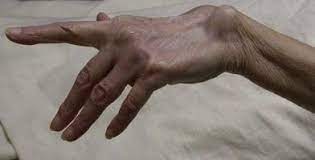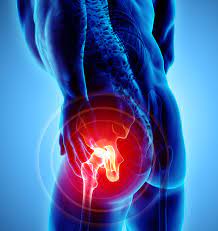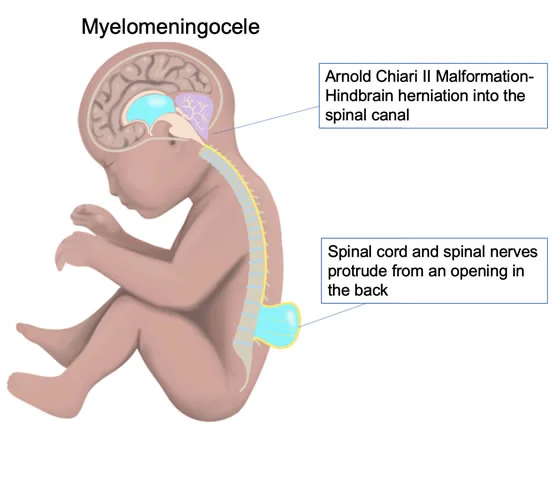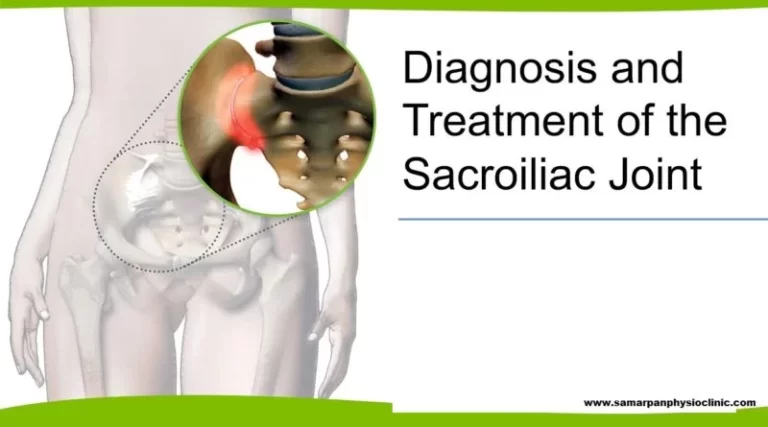Vaughan jackson syndrome
Table of Contents
Description
Vaughan Jackson Syndrome, also known as extensor tendon rupture, is a known complication of rheumatoid arthritis (RA). Rheumatoid arthritis is indeed an autoimmune disease characterized by chronic inflammation in the joints, leading to pain, swelling, and joint damage. In some cases, this inflammation can extend to the tendons, causing weakening and degenerative changes.
In Vaughan Jackson syndrome, the chronic inflammation that accompanies the disease in rheumatoid arthritis can affect the tendons, making them weaker and more susceptible to damage. Over time, the tendon can undergo degenerative changes that make it more prone to tearing even with minor trauma or stress.
Vaughan Jackson syndrome in rheumatoid arthritis most often occurs in the hands and wrists, affecting the tendons responsible for extending the fingers and wrists. A tear can cause dysfunction, pain and deformity.
If Vaughan Jackson syndrome is suspected in people with rheumatoid arthritis, it is important to consult a rheumatologist or orthopedist. They assess the severity of the injury, consider the person’s general health status and disease activity, and determine the most appropriate treatment method.
Anatomy of Vaughan Jackson Syndrome or Extensor Tendon Rupture
In rheumatoid arthritis (RA), Vaughan Jackson syndrome usually occurs in the hands and wrists. To understand the anatomy of Vaughan Jackson syndrome in rheumatoid arthritis, it is helpful to have a basic understanding of the tendons involved and their location. The extensor tendons of the hand and wrist are responsible for extending or straightening the joints of the fingers and wrist. They run from the muscles of the forearm through the wrist to the fingers. Here are some of the main extensor tendons involved in arm and wrist movements:
Tendon of Extensor Carpi Radialis Brevis (ECRB):
This tendon runs along the forearm to the base of the third metacarpal, allowing the wrist to extend.
Tendon of Extensor Digitorum Communis (EDC):
This tendon runs along the back of the hand and divides into four branches, each extending to one finger. This facilitates the extension of individual finger joints.
Extensor tendon (EPL):
This tendon extends from the forearm, passes through a tunnel in the wrist called the extensor tendon, and runs along the back of the hand to reach the thumb. This allows the thumb to be extended.
- In rheumatoid arthritis, chronic inflammation and arthritis (inflammation of the synovium surrounding the joints) can cause tendon damage and weakness.
- Degenerative changes can occur in the extensor tendons, such as tendinitis, thickening of the tendon or even erosion due to the inflammatory process.
- Over time, this can increase the risk of an extensor tear.
- Vaughan Jackson syndrome in rheumatoid arthritis usually occurs in areas where tendons pass through narrow tunnels or bone protrusions.
- Tears can occur, for example, at the level of the wrist, where the extensor tendons pass through the retinaculum, or at the level of the knuckles.
- The specific location of Vaughan Jackson syndrome determines the functional impact and type of treatment required.
- Vaughan Jackson syndrome can cause loss of the ability to extend the fingers or wrists, which can cause dysfunction, deformity, and difficulty in activities that require movement of the hand and wrist.
- The correct diagnosis and treatment of rheumatoid arthritis Shvaughan Jackson syndrome must be performed by a health professional experienced in rheumatology or hand surgery.
- They consider a person’s overall disease activity, assess the extent of tendon damage and determine the most appropriate course of treatment to optimize hand function and overall results.
Epidemiology
- The epidemiology of Vaughan Jackson syndrome in rheumatoid arthritis (RA) varies depending on the population studied and the methodology used in different studies.
- However, extensor tendon rupture is considered a serious complication of rheumatoid arthritis, particularly affecting the hands and wrists.
- The incidence of Vaughan Jackson syndrome in rheumatoid arthritis varies from 4% to 37%, depending on the study population and the diagnostic criteria used.
- The incidence of Vaughan Jackson syndrome increases with the duration and severity of the disease.
- It is more often observed in people with long-term erosion and seropositive rheumatoid arthritis.
- Several factors increase the risk of rupture of the extensor tendon in rheumatoid arthritis:
Disease activity:
Higher disease activity, characterized by persistent inflammation and arthritis, is associated with an increased risk of tendon damage and rupture.
Joint Deformities:
Joint deformities such as ulnar clubfoot and swan-bone deformities commonly seen in RA can cause changes in tendon mechanics and increased stress on the extensor tendons, making them more susceptible to tearing.
Tendon inflammation and degeneration:
Chronic inflammation and ninovitis in the tendon sheath can cause tendinitis, thickening, and weakening of the tendon, making the tendon more prone to rupture.
Medications:
The use of certain disease-modifying antirheumatic drugs (DMARDs), such as glucocorticoids, has been associated with an increased risk of tendon rupture in RA.
Occupational factors:
Occupational or repetitive activities that involve repetitive hand and wrist movements can contribute to tendon wear and tear, increasing the risk of tearing in people with RA.
- Extensor tendon rupture in RA primarily affects the extensor tendons of the fingers, particularly the medial gliding of the extensor mechanism.
- Tears usually occur at the level of the metacarpophalangeal (MCP) joints and the proximal interphalangeal (PIP) joints.
- It is important to note that the incidence and prevalence of extensor tendon rupture may vary between studies due to study design, patient populations, diagnostic criteria, and other factors.
- In addition, improvements in RA treatment, including early and aggressive treatment strategies, may have influenced the epidemiology of extensor tendon rupture in recent years.
- If you have specific concerns about the epidemiology or personal risk of extensor tendon rupture in RA, I recommend contacting a physician, such as a rheumatologist, who can provide personalized information and guidance based on your medical history and current condition.
Symptoms
The clinical picture of Vaughan Jackson syndrome in rheumatoid arthritis (RA) can vary depending on the specific tendons and the severity of the tear. Here are some of the more common clinical signs associated with an RA extensor tendon tear:
Finger and wrist deformity:
- Vaughan Jackson syndrome can cause characteristic finger deformities such as swan neck deformities or boutonniere deformities.
- In swan neck deformities, the proximal interphalangeal (PIP) joint of the affected finger is extended while the distal interphalangeal (DIP) joint is flexed.
- In boutonniere deformities, the PIP joint flexes while the DIP joint hyperextends.
Inability to extend the finger or wrist:
- A tear in the supporting tendons impairs their ability to fully extend the finger or wrist joint.
- Patients may have difficulty straightening the finger or wrist, resulting in reduced range of motion and dysfunction.
Visible gap or defect:
In some cases, there may be a visible gap or defect above the tendon tear. It is often felt.
Pain and swelling:
- Tendon tears may be associated with pain and swelling in the affected area.
- The severity of the pain can vary depending on the extent of the tear and the associated inflammation.
Functional Impairment:
Extensor tendon tears can significantly affect hand and wrist function, making activities such as grasping, grasping, and fine motor tasks difficult.
- It is important to note that the clinical presentation of Vaughan Jackson syndrome may overlap with other hand and wrist disorders.
- Therefore, proper diagnosis and evaluation by a physician such as a rheumatologist or hand surgeon is critical.
- They will perform a physical exam, review the patient’s medical history, and may use imaging tests, such as X-rays or ultrasounds, to confirm the diagnosis and assess the extent of tendon damage.
- If you suspect that an extensor tendon tear is related to rheumatoid arthritis, it is recommended that you speak with a doctor for an accurate diagnosis and appropriate treatment recommendations based on your specific situation.
Diagnosis
The diagnosis of rheumatoid arthritis (RA) Vaughan Jackson syndrome usually involves a combination of clinical evaluation, medical history review and imaging studies. Here are the main components involved in diagnosing an RA extensor tendon tear:
Medical history and physical exam:
- Your healthcare provider will begin by reviewing your medical history and asking about any symptoms you may have, such as finger or wrist extension, pain, or deformity.
- They will also perform a physical examination, evaluating the affected joints, looking for visible gaps or defects, and evaluating the range of motion of the fingers and wrists.
Imaging studies:
X-rays and ultrasound
- These are often used to evaluate Vaughan Jackson syndrome.
- X-rays can help detect bone abnormalities, joint erosions, or joint deformities associated with rheumatoid arthritis.
- Ultrasound can produce detailed images of tendons that can directly detect tendon tears or other abnormalities such as inflammation or thickening.
Magnetic resonance imaging (MRI):
- In some cases, an MRI may be ordered to assess the extent of damage to the tendons and the surrounding soft tissues.
- An MRI can provide detailed images of the tendons to help confirm the diagnosis and determine the severity of the tear.
- It is important to distinguish Vaughan Jackson syndrome from other hand and wrist conditions that may have similar symptoms.
- Conditions such as tenosynovitis, flexor tendon rupture, or nerve compression syndrome may have overlapping clinical features.
- A healthcare provider will consider these options and may order additional tests or consult with specialists to confirm the diagnosis.
- A diagnosis of Vaughan Jackson syndrome in rheumatoid arthritis requires a thorough evaluation by a healthcare professional, such as a rheumatologist or hand specialist.
- They will consider your symptoms, physical exam results, and imaging results to determine the presence and extent of a tendon tear.
- Once the diagnosis is confirmed, appropriate treatments can be discussed, which may include non-surgical procedures (eg, splints, manual therapy) and, in some cases, surgical repair of the tendon to restore function and improve outcomes.
- Please note that this information is not a substitute for professional medical advice and it is always recommended to consult a doctor for an accurate diagnosis and appropriate treatments for your particular situation.
Differential diagnosis
When evaluating a patient with suspected rheumatoid arthritis (RA) extensor tendon rupture, it is important to consider other conditions that may cause similar symptoms. Below given are some possible differential diagnoses to consider:
Tenosynovitis:
- Tenosynovitis is inflammation of the tendon sheaths, which can cause pain, swelling and limited joint movement.
- It can be seen in different types of arthritis, including RA.
- In tenosynovitis, the tendon itself is not necessarily torn, but it can be inflamed and thickened, mimicking the symptoms of a tendon tear.
Flexor Tendon Tear:
- Although extensor tendon tears are more common in rheumatoid arthritis, they can also occur.
- Flexor tendon tears can cause similar symptoms, such as difficulty bending the fingers or wrist.
- It is important to assess both the extensor and flexor tendons to identify the specific site of injury.
Nerve entrapment syndromes:
- Symptoms such as carpal tunnel syndrome or ulnar nerve entrapment can cause symptoms similar to an extensor tendon tear, including arm weakness, pain, and difficulty moving a finger or wrist.
- These conditions involve nerve compression or irritation rather than tendon damage.
Osteoarthritis:
- Osteoarthritis can affect the finger and wrist joints, causing joint pain, swelling and limited range of motion.
- It can sometimes be difficult to distinguish between joint damage caused by rheumatoid arthritis and joint damage caused by osteoarthritis.
Other rheumatic diseases:
- There are other inflammatory arthritis conditions, such as psoriatic arthritis or systemic lupus erythematosus (SLE), that can cause arthritis and tendon abnormalities that resemble rheumatoid arthritis.
- An accurate diagnosis requires a comprehensive evaluation by a healthcare professional, such as a rheumatologist or hand specialist.
- They will consider your medical history, physical exam results, and may use imaging studies to confirm the diagnosis and differentiate these different conditions.
- It is important to consult a doctor for an accurate diagnosis and appropriate treatment options based on your specific symptoms and medical history.
Medical treatment
Medical management of Vaughan Jackson syndrome in the context of rheumatoid arthritis (RA) focuses on underlying disease activity and symptoms related to tendon rupture. Here are some medical approaches to consider:
Disease-modifying anti-rheumatic drugs (DMARDs):
- DMARDs such as methotrexate, sulfasalazine, or biologics such as tumor necrosis factor inhibitors are commonly used to treat rheumatoid arthritis.
- The purpose of these medications is to suppress inflammation, slow joint damage, and reduce the risk of tendon tears.
Glucocorticoids:
- Short-term use of oral or intra-articular glucocorticoids may be considered to reduce inflammation and control symptoms associated with tendon rupture.
- However, long-term or high doses of glucocorticoids should be avoided due to their potential side effects.
Nonsteroidal anti-inflammatory drugs (NSAIDs):
- Anti-inflammatory drugs such as ibuprofen or naproxen may be used to relieve pain and reduce inflammation associated with an extensor tendon tear.
- They give symptomatic relief but do not change the underlying disease process.
Physical and occupational therapy:
- A referral to a physical or occupational therapist who specializes in manual therapy can be helpful.
- They can provide exercises and techniques to help restore range of motion, improve arm strength, and optimize functional abilities.
Assistive devices:
- Splints or braces may be prescribed to support and protect the affected arm or wrist, promote healing, and reduce stress on the tendons during daily activities.
Pain management
- Depending on the severity of the pain, your healthcare provider may recommend over-the-counter pain relievers or prescribe stronger pain relievers to relieve the pain associated with an extensor tendon tear.
Patient education:
- Education about joint protection, active modification, and ergonomic strategies can help reduce stress on tendons and joints, reducing the risk of further damage or worsening of symptoms.
- It is important to note that the specific medical approach will vary based on the unique circumstances of the individual, the severity of the disease and the extent of the tendon tear.
- A treatment plan should be tailored to the patient’s needs and goals, and decisions about medication use should be made in collaboration with a healthcare professional, such as a rheumatologist or chiropractor.
- Surgical procedures, such as tendon repair or reconstruction, may be necessary in cases of severe or functionally limiting extensor tendon tears.
- The decision for surgical treatment is usually made in collaboration with a hand surgeon and is based on the person’s overall condition and goals.
- Consultation with a healthcare professional is recommended for advice and management strategies tailored to your situation.
Physical therapy plays an essential role in the treatment of Vaughan Jackson syndrome caused by rheumatoid arthritis (RA). The main goals of physical therapy in this context are to promote healing, restore function, improve range of motion, and reduce pain. Here are some common physical therapy interventions that can be used:
Physiotherapy treatment
Exercises:
- A physiotherapist will guide you through specific exercises aimed at improving the movement of the affected joints.
- These exercises may include light stretching, active and passive range of motion, and joint mobilization.
Strengthening exercises:
- Strengthening the muscles around affected joints can help compensate for weakened tendons.
- A physical therapist will prescribe exercises that target appropriate muscle groups, often using resistance bands or light weights.
Hand therapy:
- Hand therapy focuses on optimizing hand function and fine motor skills.
- A physical therapist may use special techniques to improve hand function, such as exercises to strengthen grip, dexterity, and coordination exercises.
Splints and Orthotics:
- Custom splints or orthotics may be recommended to support and protect affected joints and tendons.
- These devices can help reduce tendon stress, promote healing, and improve functional abilities.
Pain management techniques:
- Physical therapists may use a variety of pain management techniques to relieve pain associated with tendon tears, including heat or cold therapy, ultrasound, transcutaneous electrical nerve stimulation (TENS), or manual therapy techniques.
Education and home exercise program:
- A physiotherapist will teach you joint protection techniques, ergonomic modifications and strategies to optimize daily life.
- They also offer a home exercise program that you can continue on your own to maintain and improve the gains made during the therapy sessions.
Functional Rehabilitation:
- Depending on your specific functional goals and requirements, a physical therapist may add functional training to your rehabilitation program.
- This may include exercises that simulate real-life activities such as grasping objects, writing or using tools.
- It is important to note that physical therapy for an extensor tendon tear in rheumatoid arthritis must be tailored to the needs of the individual, taking into account the severity of the tear, general health status and functional goals.
- It is recommended to consult with a physiotherapist who specializes in hand therapy or rehabilitation to receive personalized assessment and treatment strategies.
- Collaboration among the rheumatologist, hand surgeon, and physiotherapist is crucial to develop a comprehensive and coordinated management plan that addresses both the medical and rehabilitation aspects of extensor tendon rupture in RA.
Surgical treatment
- Primary Tendon Repair
- Tendon Transfers
FAQs
Extensor pollicis longus (EPL) is the most common extensor tear in rheumatoid arthritis. Functionally significant EPL tears are usually treated with extensor indicis proprius (EIP) tendon transfer.
In tendons, RA can cause tenosynovitis, triggering finger and tendon tears. Tenosynovitis – the tendon sheath around the tendons becomes very inflamed and painful.
Tendon tears in Vaughan-Jackson syndrome are primarily caused by progressive abrasion of the tendons of the ulnar head, which in RA can sublux or migrate dorsally due to loss of normal supporting structures.
Name “caput ulnae syndrome”. Main clinical features. are: (1) rotational pain, weakness, and limitation of motion. the wrist, (2) the ulna is displaced and forms the back. the wrist (3) in the back elbow position is delicately soft.
The word Vaughan-Jackson syndrome tends to disruption of the digital extensor tendons, starting on the ulnar side of the hand and wrist with the extensor digiti minimi (EDM) and extensor digitorum communis (EDC) tendon of the tiny finger.







